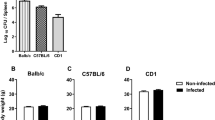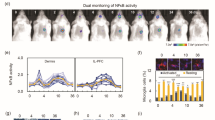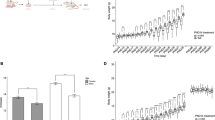Abstract
Endogenous glucocorticoids restrain proinflammatory cytokine responses to immune challenges such as viral infection. In addition, proinflammatory cytokines induce behavioral alterations including changes in locomotor/exploratory activity. Accordingly, we examined proinflammatory cytokines and open-field behavior in virally infected mice rendered glucocorticoid deficient by adrenalectomy (ADX). Mice were infected with murine cytomegalovirus (MCMV), and open-field behavior (36 h post-infection) and plasma concentrations of tumor necrosis factor (TNF)-alpha and interleukin (IL)-6 (42 h post-infection) were assessed. Compared to sham-ADX-MCMV-infected animals, ADX-MCMV-infected mice exhibited significant reductions in total distance moved, number of center entries, and time spent in center. These behavioral alterations were accompanied by significantly higher plasma concentrations of TNF-alpha and IL-6, both of which were correlated with degree of behavioral change. To examine the role of TNF-alpha in these behavioral alterations, open-field behavior was compared in wild-type (WT) and TNF-R1-knockout (KO), ADX-MCMV-infected mice. TNF-R1-KO mice exhibited significantly attenuated decreases in number of rearings, number of center entries and time spent in center, but not distance moved, which correlated with plasma IL-6. Given the potential role of brain cytokines in these findings, mRNA expression of TNF-alpha, IL-1 and IL-6 was assessed in various brain regions. Although MCMV induced increases in proinflammatory cytokine mRNA throughout the brain (especially in ADX animals), no remarkable differences were found between WT and TNF-R1-KO mice. These results demonstrate that endogenous glucocorticoids restrain proinflammatory cytokine responses to viral infection and their impact on locomotor/exploratory activity. Moreover, TNF-alpha appears to mediate cytokine-induced changes in open-field behaviors, especially those believed to reflect anxiety.
This is a preview of subscription content, access via your institution
Access options
Subscribe to this journal
Receive 12 print issues and online access
$259.00 per year
only $21.58 per issue
Buy this article
- Purchase on Springer Link
- Instant access to full article PDF
Prices may be subject to local taxes which are calculated during checkout






Similar content being viewed by others
References
Silverman MN, Pearce BD, Biron CA, Miller AH . Immune modulation of the hypothalamic–pituitary–adrenal (HPA) axis during viral infection. Viral Immunol 2005; 18: 41–78.
Turnbull AV, Rivier CL . Regulation of the hypothalamic-pituitary-adrenal axis by cytokines: actions and mechanisms of action. Physiol Rev 1999; 79: 1–71.
Silverman MN, Miller AH, Biron CA, Pearce BD . Characterization of an interleukin-6- and adrenocorticotropin-dependent, immune-to-adrenal pathway during viral infection. Endocrinology 2004; 145: 3580–3589.
Glezer I, Rivest S . Glucocorticoids: protectors of the brain during innate immune responses. Neuroscientist 2004; 10: 538–552.
Miller AH, Pearce BD, Ruzek MC, Biron CA . Interactions between the hypothalamic-pituitary-adrenal axis and immune system during viral infection: pathways for environmental effects on disease expression. In: McEwen BS (ed). Handbook of Physiology. Oxford University Press: New York, 2001, pp 425–450.
Schobitz B, Reul JM, Holsboer F . The role of the hypothalamic-pituitary-adrenocortical system during inflammatory conditions. Crit Rev Neurobiol 1994; 8: 263–291.
Webster JI, Sternberg EM . Role of the hypothalamic-pituitary-adrenal axis, glucocorticoids and glucocorticoid receptors in toxic sequelae of exposure to bacterial and viral products. J Endocrinol 2004; 181: 207–221.
Adcock IM, Caramori G . Cross-talk between pro-inflammatory transcription factors and glucocorticoids. Immunol Cell Biol 2001; 79: 376–384.
De Bosscher K, Vanden Berghe W, Haegeman G . Mechanisms of anti-inflammatory action and of immunosuppression by glucocorticoids: negative interference of activated glucocorticoid receptor with transcription factors. J Neuroimmunol 2000; 109: 16–22.
Kovalovsky D, Refojo D, Holsboer F, Arzt E . Molecular mechanisms and Th1/Th2 pathways in corticosteroid regulation of cytokine production. J Neuroimmunol 2000; 109: 23–29.
Webster JC, Cidlowski JA . Mechanisms of glucocorticoid-receptor-mediated repression of gene transcription. Trends Endocrinol Metab 1999; 10: 396–402.
Nadeau S, Rivest S . Glucocorticoids play a fundamental role in protecting the brain during innate immune response. J Neurosci 2003; 23: 5536–5544.
Kapcala LP, Chautard T, Eskay RL . The protective role of the hypothalamic-pituitary-adrenal axis against lethality produced by immune, infectious, and inflammatory stress. Ann NY Acad Sci 1995; 771: 419–437.
Price P, Olver SD, Silich M, Nador TZ, Yerkovich S, Wilson SG . Adrenalitis and the adrenocortical response of resistant and susceptible mice to acute murine cytomegalovirus infection. Eur J Clin Invest 1996; 26: 811–819.
Ruzek MC, Pearce BD, Miller AH, Biron CA . Endogenous glucocorticoids protect against cytokine-mediated lethality during viral infection. J Immunol 1999; 162: 3527–3533.
Ruzek MC, Miller AH, Opal SM, Pearce BD, Biron CA . Characterization of early cytokine responses and an interleukin (IL)-6-dependent pathway of endogenous glucocorticoid induction during murine cytomegalovirus infection. J Exp Med 1997; 185: 1185–1192.
Dantzer R . Cytokine-induced sickness behavior: where do we stand? Brain Behav Immun 2001; 15: 7–24.
Maier SF, Watkins LR . Cytokines for psychologists: implications of bidirectional immune-to-brain communication for understanding behavior, mood, and cognition. Psychol Rev 1998; 105: 83–107.
Dunn AJ, Swiergiel AH . The role of cytokines in infection-related behavior. Ann NY Acad Sci 1998; 840: 577–585.
Anisman H, Merali Z, Poulter MO, Hayley S . Cytokines as a precipitant of depressive illness: animal and human studies. Curr Pharm Des 2005; 11: 963–972.
Barak O, Goshen I, Ben-Hur T, Weidenfeld J, Taylor AN, Yirmiya R . Involvement of brain cytokines in the neurobehavioral disturbances induced by HIV-1 glycoprotein120. Brain Res 2002; 933: 98–108.
Bluthe RM, Laye S, Michaud B, Combe C, Dantzer R, Parnet P . Role of interleukin-1beta and tumour necrosis factor-alpha in lipopolysaccharide-induced sickness behaviour: a study with interleukin-1 type I receptor-deficient mice. Eur J Neurosci 2000; 12: 4447–4456.
Bluthe RM, Michaud B, Poli V, Dantzer R . Role of IL-6 in cytokine-induced sickness behavior: a study with IL-6 deficient mice. Physiol Behav 2000; 70: 367–373.
Kozak W, Poli V, Soszynski D, Conn CA, Leon LR, Kluger MJ . Sickness behavior in mice deficient in interleukin-6 during turpentine abscess and influenza pneumonitis. Am J Physiol 1997; 272: R621–R630.
Maier SF, Wiertelak EP, Martin D, Watkins LR . Interleukin-1 mediates the behavioral hyperalgesia produced by lithium chloride and endotoxin. Brain Res 1993; 623: 321–324.
Morrow JD, Opp MR . Diurnal variation of lipopolysaccharide-induced alterations in sleep and body temperature of interleukin-6-deficient mice. Brain Behav Immun 2005; 19: 40–51.
Pugh CR, Johnson JD, Martin D, Rudy JW, Maier SF, Watkins LR . Human immunodeficiency virus-1 coat protein gp120 impairs contextual fear conditioning: a potential role in AIDS related learning and memory impairments. Brain Res 2000; 861: 8–15.
Swiergiel AH, Smagin GN, Johnson LJ, Dunn AJ . The role of cytokines in the behavioral responses to endotoxin and influenza virus infection in mice: effects of acute and chronic administration of the interleukin-1-receptor antagonist (IL-1ra). Brain Res 1997; 776: 96–104.
Swiergiel AH, Dunn AJ . The roles of IL-1, IL-6, and TNFalpha in the feeding responses to endotoxin and influenza virus infection in mice. Brain Behav Immun 1999; 13: 252–265.
Yirmiya R, Weidenfeld J, Barak O, Avitsur R, Pollak Y, Gallily R et al. The role of brain cytokines in mediating the behavioral and neuroendocrine effects of intracerebral mycoplasma fermentans. Brain Res 1999; 829: 28–38.
Pollak Y, Ovadia H, Orion E, Yirmiya R . The EAE-associated behavioral syndrome: II. Modulation by anti-inflammatory treatments. J Neuroimmunol 2003; 137: 100–108.
Prut L, Belzung C . The open field as a paradigm to measure the effects of drugs on anxiety-like behaviors: a review. Eur J Pharmacol 2003; 463: 3–33.
Belzung C, Griebel G . Measuring normal and pathological anxiety-like behaviour in mice: a review. Behav Brain Res 2001; 125: 141–149.
Yirmiya R, Rosen H, Donchin O, Ovadia H . Behavioral effects of lipopolysaccharide in rats: involvement of endogenous opioids. Brain Res 1994; 648: 80–86.
Yirmiya R . Endotoxin produces a depressive-like episode in rats. Brain Res 1996; 711: 163–174.
Yirmiya R, Barak O, Avitsur R, Gallily R, Weidenfeld J . Intracerebral administration of Mycoplasma fermentans produces sickness behavior: role of prostaglandins. Brain Res 1997; 749: 71–81.
Szechtman H, Sakic B, Denburg JA . Behaviour of MRL mice: an animal model of disturbed behaviour in systemic autoimmune disease. Lupus 1997; 6: 223–229.
Schobitz B, Pezeshki G, Pohl T, Hemmann U, Heinrich PC, Holsboer F et al. Soluble interleukin-6 (IL-6) receptor augments central effects of IL-6 in vivo. FASEB J 1995; 9: 659–664.
Bianchi M, Sacerdote P, Ricciardi-Castagnoli P, Mantegazza P, Panerai AE . Central effects of tumor necrosis factor alpha and interleukin-1 alpha on nociceptive thresholds and spontaneous locomotor activity. Neurosci Lett 1992; 148: 76–80.
Yirmiya R, Avitsur R, Donchin O, Cohen E . Interleukin-1 inhibits sexual behavior in female but not in male rats. Brain Behav Immun 1995; 9: 220–233.
Lacosta S, Merali Z, Anisman H . Influence of interleukin-1beta on exploratory behaviors, plasma ACTH, corticosterone, and central biogenic amines in mice. Psychopharmacology 1998; 137: 351–361.
Dunn AJ, Swiergiel AH . Effects of interleukin-1 and endotoxin in the forced swim and tail suspension tests in mice. Pharmacol Biochem Behav 2005; 81: 688–693.
Pfeffer K, Matsuyama T, Kundig TM, Wakeham A, Kishihara K, Shahinian A et al. Mice deficient for the 55 kd tumor necrosis factor receptor are resistant to endotoxic shock, yet succumb to L. monocytogenes infection. Cell 1993; 73: 457–467.
Pezeshki G, Pohl T, Schobitz B . Corticosterone controls interleukin-1 beta expression and sickness behavior in the rat. J Neuroendocrinol 1996; 8: 129–135.
Barak O, Weidenfeld J, Goshen I, Ben-Hur T, Taylor AN, Yirmiya R . Intracerebral HIV-1 glycoprotein 120 produces sickness behavior and pituitary-adrenal activation in rats: role of prostaglandins. Brain Behav Immun 2002; 16: 720–735.
Schrott LM, Crnic LS . Increased anxiety behaviors in autoimmune mice. Behav Neurosci 1996; 110: 492–502.
Yamada K, Iida R, Miyamoto Y, Saito K, Sekikawa K, Seishima M et al. Neurobehavioral alterations in mice with a targeted deletion of the tumor necrosis factor-alpha gene: implications for emotional behavior. J Neuroimmunol 2000; 111: 131–138.
Fiore M, Probert L, Kollias G, Akassoglou K, Alleva E, Aloe L . Neurobehavioral alterations in developing transgenic mice expressing TNF-alpha in the brain. Brain Behav Immun 1996; 10: 126–138.
Fiore M, Alleva E, Probert L, Kollias G, Angelucci F, Aloe L . Exploratory and displacement behavior in transgenic mice expressing high levels of brain TNF-alpha. Physiol Behav 1998; 63: 571–576.
Connor TJ, Song C, Leonard BE, Merali Z, Anisman H . An assessment of the effects of central interleukin-1beta, -2, -6, and tumor necrosis factor-alpha administration on some behavioural, neurochemical, endocrine and immune parameters in the rat. Neuroscience 1998; 84: 923–933.
Pan W, Kastin AJ, Rigai T, McLay R, Pick CG . Increased hippocampal uptake of tumor necrosis factor alpha and behavioral changes in mice. Exp Brain Res 2003; 149: 195–199.
Maes M, Song C, Lin A, De Jongh R, Van Gastel A, Kenis G et al. The effects of psychological stress on humans: increased production of pro-inflammatory cytokines and a Th1-like response in stress-induced anxiety. Cytokine 1998; 10: 313–318.
Reichenberg A, Yirmiya R, Schuld A, Kraus T, Haack M, Morag A et al. Cytokine-associated emotional and cognitive disturbances in humans. Arch Gen Psychiatry 2001; 58: 445–452.
Lokensgard JR, Chao CC, Gekker G, Hu S, Peterson PK . Benzodiazepines, glia, and HIV-1 neuropathogenesis. Mol Neurobiol 1998; 18: 23–33.
Taupin V, Jayais P, Descamps-Latscha B, Cazalaa JB, Barrier G, Bach JF et al. Benzodiazepine anesthesia in humans modulates the interleukin-1 beta, tumor necrosis factor-alpha and interleukin-6 responses of blood monocytes. J Neuroimmunol 1991; 35: 13–19.
Zavala F, Taupin V, Descamps-Latscha B . In vivo treatment with benzodiazepines inhibits murine phagocyte oxidative metabolism and production of interleukin 1, tumor necrosis factor and interleukin-6. J Pharmacol Exp Ther 1990; 255: 442–450.
Watanobe H, Takebe K . Intravenous administration of tumor necrosis factor-alpha stimulates corticotropin releasing hormone secretion in the push-pull cannulated median eminence of freely moving rats. Neuropeptides 1992; 22: 81–84.
Bernardini R, Kamilaris TC, Calogero AE, Johnson EO, Gomez MT, Gold PW et al. Interactions between tumor necrosis factor-alpha, hypothalamic corticotropin-releasing hormone, and adrenocorticotropin secretion in the rat. Endocrinology 1990; 126: 2876–2881.
Butterweck V, Prinz S, Schwaninger M . The role of interleukin-6 in stress-induced hyperthermia and emotional behaviour in mice. Behav Brain Res 2003; 144: 49–56.
Lenczowski MJ, Bluthe RM, Roth J, Rees GS, Rushforth DA, van Dam AM et al. Central administration of rat IL-6 induces HPA activation and fever but not sickness behavior in rats. Am J Physiol 1999; 276: R652–R658.
Raison CL, Miller AH . When not enough is too much: the role of insufficient glucocorticoid signaling in the pathophysiology of stress-related disorders. Am J Psychiatry 2003; 160: 1554–1565.
Maes M, Lin AH, Delmeire L, Van Gastel A, Kenis G, De Jongh R et al. Elevated serum interleukin-6 (IL-6) and IL-6 receptor concentrations in posttraumatic stress disorder following accidental man-made traumatic events. Biol Psychiatry 1999; 45: 833–839.
Sluzewska A, Rybakowski J, Bosmans E, Sobieska M, Berghmans R, Maes M et al. Indicators of immune activation in major depression. Psychiatry Res 1996; 64: 161–167.
Lanquillon S, Krieg JC, Bening-Abu-Shach U, Vedder H . Cytokine production and treatment response in major depressive disorder. Neuropsychopharmacology 2000; 22: 370–379.
Cannon JG, Angel JB, Ball RW, Abad LW, Fagioli L, Komaroff AL . Acute phase responses and cytokine secretion in chronic fatigue syndrome. J Clin Immunol 1999; 19: 414–421.
Demitrack MA, Crofford LJ . Evidence for and pathophysiologic implications of hypothalamic-pituitary-adrenal axis dysregulation in fibromyalgia and chronic fatigue syndrome. Ann NY Acad Sci 1998; 840: 684–697.
Acknowledgements
We thank Drs Brad Pearce and Gerald Vogt (Emory University, Atlanta, GA) for their help in harvesting low stress samples. In addition, we thank Dr Christine Biron (Brown University, Providence, RI) for supplying stocks of MCMV, and Minida Dowdy (Emory University, Atlanta, GA) for managing the TNF-R1-KO breeding colony. This work was supported in part by National Institute of Health Grants, MH47674 (AHM), MH00680 (AHM) and F31-MH63598 (MNS).
Author information
Authors and Affiliations
Corresponding author
Rights and permissions
About this article
Cite this article
Silverman, M., Macdougall, M., Hu, F. et al. Endogenous glucocorticoids protect against TNF-alpha-induced increases in anxiety-like behavior in virally infected mice. Mol Psychiatry 12, 408–417 (2007). https://doi.org/10.1038/sj.mp.4001921
Received:
Revised:
Accepted:
Published:
Issue Date:
DOI: https://doi.org/10.1038/sj.mp.4001921
Keywords
This article is cited by
-
Dorsal hippocampal interleukin-1 signaling mediates heroin withdrawal-enhanced fear learning
Psychopharmacology (2020)
-
Inhibition of TNF-α-induced neuronal apoptosis by antidepressants acting through the lysophosphatidic acid receptor LPA1
Apoptosis (2019)
-
The Role of Brain Interleukin-1 in Stress-Enhanced Fear Learning
Neuropsychopharmacology (2015)
-
GWAS, Cytomegalovirus Infection, and Schizophrenia
Current Behavioral Neuroscience Reports (2014)
-
Glucocorticoid receptor dimerization is required for proper recovery of LPS-induced inflammation, sickness behavior and metabolism in mice
Molecular Psychiatry (2013)



